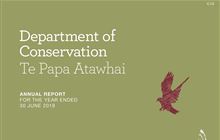National status and trend reports 2019-2020
Introduction
Explore some findings from DOC's Monitoring and Reporting System on New Zealand's biodiversity and the introduced animals and plants that threaten it, and peoples' participation in recreation. These factsheets are supporting technical information for the Annual Report 2019-20.We use an Outcomes Monitoring Framework (OMF) to support our statements around outcomes and performance.
General factsheets
Information to increase our understanding of New Zealand's biodiversity.
Distribution maps of mammalian pressures
Factsheets on a specific indicator or measure
Interactive factual evidence that is delivered as progress reports on implemented indicators and measures:
Biodiversity
Ecosystem representation and changes in the ecological integrity of managed ecosystems
Management of priority ecosystems; and ecosystem representation and change in ecological integrity of managed ecosystems
How well are threatened ecosystems protected?
How well are threatened terrestrial and wetland ecosystems protected?
Proportion of marine ecosystems protected
The area of New Zealand's marine environment that is within marine reserves and marine mammal sanctuaries
Proportion of LENZ environments protected and under indigenous cover
Assessing the overall changes in New Zealand's native vegetation by environment type
Status and trends of common and widespread bird species
Assessment of status and trend in common and widespread terrestrial species across all public conservation land (PCL) in New Zealand
Number of managed indigenous species
The number of species populations receiving management indicates progress towards securing a wide range of threatened and at-risk taxa from extinction
Distributions of nocturnal birds on public conservation land
Recording presence of nocturnal bird species using bird counts and automatic monitoring devices improves our knowledge of their distributions
Population dynamics of kākāpō
Current determination of the population demographics of kākāpō
Improvements in kākā demographics in Waitutu Forest and the Eglinton Valley, Fiordland
Determining the sex and age structures of kākā populations as an effective alternative to counts to assess the effectiveness of landscape-scale pest control
Population dynamics of long-tailed bats in the Eglinton Valley, Fiordland
Trends in demography of a managed threatened species population can indicate management effectiveness
Survival rates for short-tailed bats at two managed sites
Estimating the annual survival of short-tailed bats in the Eglinton Valley, Fiordland and in Pureora Forest in the King Country
Abundance and distribution of possums
Estimates of possums' national distribution and abundance can help direct control efforts on PCL, also provides important baseline information against which future assessments and different management interventions can be compared
Abundance and distribution of ungulates
Estimates of ungulates' national distribution and abundance can help direct control efforts on PCL, and provides important baseline information against which future assessments and different management interventions can be compared
Impacts of commercial deer recovery on forest and alpine vegetation in Fiordland National Park
Monitoring results on how commercial deer recovery is affecting alpine and forest vegetation in Fiordland National Park
Abundances and distributions of rabbits and hares
Estimates of national abundances and distributions of rabbits and hares can help direct control efforts on PCL, and provides important baseline information against which future assessments and different management interventions can be compared
Recreation
International Visitor Survey results
How many international visitors visit our National Parks?
Visitor Satisfaction with DOC's Great Walks
Understanding visitors' experiences through their eyes is essential if DOC is to continue to provide outstanding visitor experiences on its world-renowned Great Walks
Visitor safety on DOC's Great Walks
Visitors' perceptions and experiences regarding their own safety and wellbeing on Great Walks helps ensure the effectiveness of DOC's safety-related efforts
Visitor satisfaction with DOC's 'Short Walks' and 'Day Hikes'
Understanding visitors' experiences through their eyes is essential if DOC is to continue to provide outstanding visitor experiences on its 'Short Walks' and 'Day Hikes'
Distribution of DOC assets across public conservation land
DOC invests heavily in the construction and maintenance of an extensive portfolio of visitor assets across Aotearoa/New Zealand to support recreational opportunities on public conservation land and waters
Utilisation of DOC assets
To ensure visitors continue to enjoy outstanding experiences on PCL and waters, DOC uses activity counters to record the level of public utilisation of its visitor assets to help guide investment and operational planning
Standard of DOC assets
DOC invests heavily in an extensive portfolio of visitor assets to support recreational opportunities on public conservation lands and waters. These assets undergo continual inspection and maintenance to ensure they continue to meet the expectations of visitors and remain safe to use

